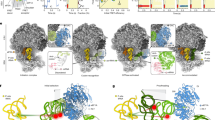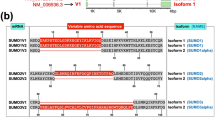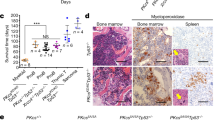Abstract
Decay-accelerating factor (DAF), a glycoprotein that is anchored to the cell membrane by phosphatidylinositol1,2, binds activated complement fragments C3b and C4b, thereby inhibiting amplification of the complement cascade on host cell membranes3–5. Here, we report the molecular cloning of human DAF from HeLa cells. Analysis of DAF complementary DNAs revealed two classes of DAF messenger RNA, one apparently derived from the other by a splicing event that causes a coding frameshift near the C terminus. The apparent 'intron' sequence contains an Alu family member and encodes contiguous protein sequence. Two DAF proteins are therefore possible, having divergent C-terminal domains which differ in their hydrophobicity. Both mRNAs are found on polysomes, suggesting that both are translated. We propose that the major (90%) spliced DAF mRNA encodes membrane-bound DAF whereas the minor (10%) unspliced DAF mRNA may encode secreted DAF and we present expression data supporting this. The deduced DAF sequence contains four repeating units homologous to a consensus repeat found in a recently described family of complement proteins6.
This is a preview of subscription content, access via your institution
Access options
Subscribe to this journal
Receive 51 print issues and online access
$199.00 per year
only $3.90 per issue
Buy this article
- Purchase on Springer Link
- Instant access to full article PDF
Prices may be subject to local taxes which are calculated during checkout
Similar content being viewed by others
References
Davitz, M. A., Low, M. G. & Nussenzweig, V. J. exp. Med. 163, 1150–1161 (1986).
Medof, M. E., Haas, R., Walter, E. I. & Rosenberry, T. L. Fed. Proc. 45, 382 (1986).
Nicholson-Weller, A. J. et al. J. Immun. 129, 184–189 (1982).
Medof, M. E., Kinoshita, T. & Nussenzweig, V. J. exp. Med. 160, 1558–1578 (1984).
Kinoshita, T., Medof, M. E. & Nussenzweig, V. J. Immun. 136, 3390–3395 (1986).
Reid, K. B. M. et al. Immun. Today 7, 230 (1986).
Anderson, S. & Kingston, I. B. Proc. natn. Acad. Sci. U.S.A. 80, 6836–6842 (1983).
Ullrich, A. et al. Nature 316, 418–425 (1984).
Davitz, M. A., Schiesinger, D. & Nussenzweig, V. J. Immun. Meth. (in the press).
Kozak, M. Microbiol. Rev. 57, 1–45 (1983).
Cummings, R. D. et al. J. biol. Chem. 258, 15261–15273 (1983).
Russell, D. W. et al. Cell 37, 577–585 (1984).
Mount, S. M. Nucleic Acids Res. 10, 459–472 (1982).
Sharp, P. A. Cell 23, 643–646 (1981).
Schmidt, C. W. & Jelinek, W. R. Science 216, 1065–1070 (1982).
Proudfoot, N. J. & Brownlee, G. G. Nature 263, 211–214 (1976).
Medof, M. E. et al. Complement 2, 53 (1985).
Low, M. G., Ferguson, M. A. J., Futerman, A. H. & Silman, I. Trends biochem. Sci. 11, 212–215 (1986).
Low, M. G. & Kincade, P. W. Nature 318, 62–64 (1985).
Tse, A. G. D. et al. Science 230, 1003–1008 (1985).
Ferguson, M. A. J. et al. J. biol. Chem. 261, 356–362 (1986).
Early, P. et al. Cell 20, 313–319 (1980).
Towbin, H., Stachlin, T. & Gorden, J. Proc. natn. Acad. Sci. U.S.A. 76, 4350 (1979).
Messing, J., Crea, R. & Seeburg, P. H. Nucleic Acids Res. 9, 309–321 (1981).
Sanger, F., Nicklew, S. & Coulson, A. R. Proc. natn. Acad. Sci. U.S.A. 74, 5463–5467 (1977).
Vergara, U. et al. Molec. biochem. Parasitol. 14, 283–292 (1985).
Green, N. et al. Cell 28, 477–487 (1982).
Kyte, J. & Doolittle, R. F. J. molec. Biol. 157, 105 (1982).
Maniatis, T., Fritsch, E. F. & Sambrook, J. Molecular Cloning; a Laboratory Manual, 202–203 (Cold Spring Harbor Laboratory, New York, 1982).
Goddard, J. M., Caput, D., Williams, S. R. and Martin, D. W., Jr Proc. natn. Acad. Sci. U.S.A. 80, 4281–4285 (1983).
Maniatis, T., Fritsch, E. F. & Sambrook, J. Molecular Cloning; a Laboratory Manual, 122–124 (Cold Spring Harbor Laboratory, New York, 1982).
Taylor, J. M., Illmensee, R. & Summers, S. Biochim. biophys. Acta 442, 324–330 (1976).
Wood, W. I. et al. Proc. natn. Acad. Sci. U.S.A. 82, 1585–1588 (1985).
Gorman, C. M. et al. Proc. natn. Acad. Sci. U.S.A. 79, 6777–6781 (1982).
Simonsen, C. C. & Levinson, A. D. Proc. natn. Acad. Sci. U.S.A. 80, 2495–2499 (1983).
Wigler, M. et al. Proc. natn. Acad. Sci. U.S.A. 76, 1373–1376 (1979).
Gottlieb et al. J. Cell Biol. 102, 1242–1255 (1986).
Rose, J. K. & Bergmann, J. E. Cell 30, 753–762 (1982).
Author information
Authors and Affiliations
Rights and permissions
About this article
Cite this article
Caras, I., Davitz, M., Rhee, L. et al. Cloning of decay-accelerating factor suggests novel use of splicing to generate two proteins. Nature 325, 545–549 (1987). https://doi.org/10.1038/325545a0
Received:
Accepted:
Issue Date:
DOI: https://doi.org/10.1038/325545a0
This article is cited by
-
A functional SNP in the regulatory region of the decay-accelerating factor gene associates with extraocular muscle pareses in myasthenia gravis
Genes & Immunity (2010)
-
A Novel Glycosylphosphatidylinositol-Anchored Alkaline Phosphatase Dwells in the Hepatic Duct of the Pearl Oyster, Pinctada fucata
Marine Biotechnology (2007)
-
Decay accelerating factor and colorectal cancer
Chinese Journal of Cancer Research (2004)
-
Regulation of the New Coexpressed CD55 (Decay-Accelerating Factor) Receptor on Stomach Carcinoma Cells Involved in Antibody SC-1–Induced Apoptosis
Laboratory Investigation (2001)
Comments
By submitting a comment you agree to abide by our Terms and Community Guidelines. If you find something abusive or that does not comply with our terms or guidelines please flag it as inappropriate.



